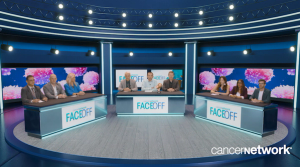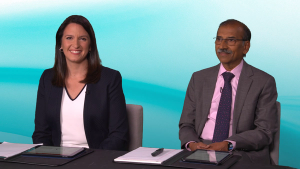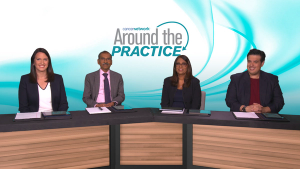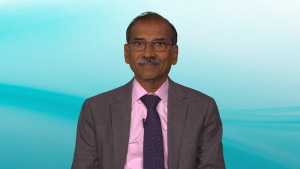Articles by Shambavi Richard, MD
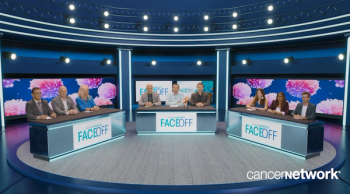
Clinical Scenario: Implementation of Bispecific Therapy for Relapsed Refractory Multiple Myeloma in a Community Center
ByAjai Chari, MD,Thomas G. Martin, MD,Jens Hillengass, MD, PhD ,Beth Faiman PhD, MSN, APN-BC,BMTCN, AOCN, FAAN, FAPO ,Louis Williams, MD,Shebli Atrash, MD ,Donna Catamero, ANP-BC, OCN, CCRC,Cesar Rodriguez Valdes, MD ,Shambavi Richard, MD Panelists discuss how community centers can effectively implement bispecific antibody therapy for patients with relapsed/refractory multiple myeloma, addressing challenges such as staff training, patient monitoring, and managing potential adverse events in a non-academic setting.

Clinical Scenario: A 58-Year Old Woman with Relapsed Refractory Mutiple Myeloma, post-ASCT, MRD-negative, on Bispecific Therapy
ByAjai Chari, MD,Thomas G. Martin, MD,Jens Hillengass, MD, PhD ,Beth Faiman PhD, MSN, APN-BC,BMTCN, AOCN, FAAN, FAPO ,Louis Williams, MD,Shebli Atrash, MD ,Donna Catamero, ANP-BC, OCN, CCRC,Cesar Rodriguez Valdes, MD ,Shambavi Richard, MD Panelists discuss how to approach treatment decisions and management strategies for a 58-year-old woman with relapsed/refractory multiple myeloma who is post-autologous stem cell transplant, MRD-negative, and currently receiving bispecific antibody therapy, considering factors such as prior treatments, response duration, and long-term treatment goals.

Dosing Interval and Considerations for Bispecifics Combination in Relapsed Refractory Multiple Myeloma
ByAjai Chari, MD,Thomas G. Martin, MD,Jens Hillengass, MD, PhD ,Beth Faiman PhD, MSN, APN-BC,BMTCN, AOCN, FAAN, FAPO ,Louis Williams, MD,Shebli Atrash, MD ,Donna Catamero, ANP-BC, OCN, CCRC,Cesar Rodriguez Valdes, MD ,Shambavi Richard, MD Panelists discuss how optimizing dosing intervals and carefully considering combination strategies for bispecific antibodies in relapsed/refractory multiple myeloma could enhance treatment efficacy while managing toxicities and improving patient quality of life.

Sequencing Therapies in Relapsed Refractory Multiple Myeloma: Bispecifics and CAR T-Cell Therapies
ByAjai Chari, MD,Thomas G. Martin, MD,Jens Hillengass, MD, PhD ,Beth Faiman PhD, MSN, APN-BC,BMTCN, AOCN, FAAN, FAPO ,Louis Williams, MD,Shebli Atrash, MD ,Donna Catamero, ANP-BC, OCN, CCRC,Cesar Rodriguez Valdes, MD ,Shambavi Richard, MD Panelists discuss how the optimal sequencing of bispecific antibodies and CAR T-cell therapies in relapsed/refractory multiple myeloma could maximize treatment efficacy and improve patient outcomes in this challenging disease setting.

OPTec: Outpatient Step Up Administration of Teclistamab: Implications in Real-World Practice
ByAjai Chari, MD,Thomas G. Martin, MD,Jens Hillengass, MD, PhD ,Beth Faiman PhD, MSN, APN-BC,BMTCN, AOCN, FAAN, FAPO ,Louis Williams, MD,Shebli Atrash, MD ,Donna Catamero, ANP-BC, OCN, CCRC,Cesar Rodriguez Valdes, MD ,Shambavi Richard, MD Panelists discuss how the OPTec study, which explores outpatient step-up administration of teclistamab, could impact real-world practice by potentially improving patient convenience and reducing healthcare resource utilization in the treatment of multiple myeloma.

Prophylactic Tocilizumab in MajesTEC-1 for the Reduction of CRS
ByAjai Chari, MD,Thomas G. Martin, MD,Jens Hillengass, MD, PhD ,Beth Faiman PhD, MSN, APN-BC,BMTCN, AOCN, FAAN, FAPO ,Louis Williams, MD,Shebli Atrash, MD ,Donna Catamero, ANP-BC, OCN, CCRC,Cesar Rodriguez Valdes, MD ,Shambavi Richard, MD Panelists discuss how prophylactic use of tocilizumab in the MajesTEC-1 trial may reduce the incidence and severity of cytokine release syndrome (CRS) in patients receiving bispecific antibody therapy for multiple myeloma, potentially improving treatment safety and tolerability.

Bispecific Antibody Combinations In Relapsed Refractory Multiple Myeloma: RedirecTT-1 Follow-Up
ByAjai Chari, MD,Thomas G. Martin, MD,Jens Hillengass, MD, PhD ,Beth Faiman PhD, MSN, APN-BC,BMTCN, AOCN, FAAN, FAPO ,Louis Williams, MD,Shebli Atrash, MD ,Donna Catamero, ANP-BC, OCN, CCRC,Cesar Rodriguez Valdes, MD ,Shambavi Richard, MD Panelists discuss how the follow-up results from the RedirecTT-1 study provide insights into the long-term efficacy and safety of bispecific antibody combinations in treating relapsed/refractory multiple myeloma, potentially shaping future treatment approaches for this challenging disease.

Bispecific Antibody Combinations In Relapsed Refractory Multiple Myeloma: TRIMM-2 Study
ByAjai Chari, MD,Thomas G. Martin, MD,Jens Hillengass, MD, PhD ,Beth Faiman PhD, MSN, APN-BC,BMTCN, AOCN, FAAN, FAPO ,Louis Williams, MD,Shebli Atrash, MD ,Donna Catamero, ANP-BC, OCN, CCRC,Cesar Rodriguez Valdes, MD ,Shambavi Richard, MD Panelists discuss how the TRIMM-2 study explores the potential of combining bispecific antibodies to enhance treatment efficacy in patients with relapsed/refractory multiple myeloma, potentially offering a novel therapeutic strategy for this difficult-to-treat condition.

Talquetamab, a GPRC5DxCD3 bispecific antibody (BsAb), for Relapsed Refractory Multiple Myeloma: MonumenTAL-1 Data and Implications
ByAjai Chari, MD,Thomas G. Martin, MD,Jens Hillengass, MD, PhD ,Beth Faiman PhD, MSN, APN-BC,BMTCN, AOCN, FAAN, FAPO ,Louis Williams, MD,Shebli Atrash, MD ,Donna Catamero, ANP-BC, OCN, CCRC,Cesar Rodriguez Valdes, MD ,Shambavi Richard, MD Panelists discuss how Talquetamab, a novel GPRC5DxCD3 bispecific antibody, shows promising results in treating relapsed/refractory multiple myeloma based on the MonumenTAL-1 trial data, potentially offering a new therapeutic option for this challenging patient population.
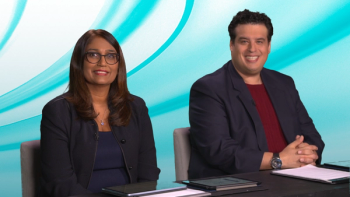
Before closing out their review on the management of multiple myeloma, panelists consider disparities in care and share how these barriers are being addressed.
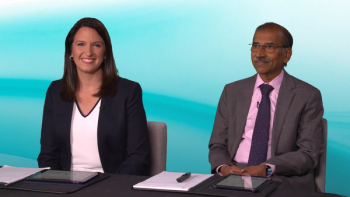
A comprehensive review of novel therapy being investigated in the setting of relapsed/refractory multiple myeloma to expand the bispecific antibody and CAR T-cell therapy armamentarium.
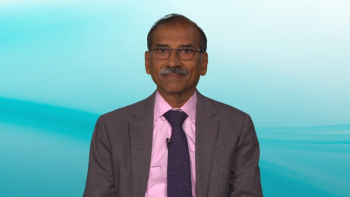
Shared insight on key factors that determine the best selection of therapy in patients with relapsed/refractory multiple myeloma, with a focus on bispecific antibodies and CAR T-cell therapy.
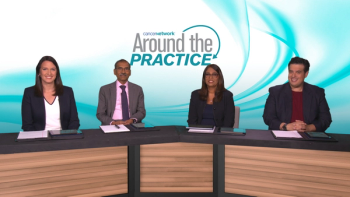
After reviewing their third patient case, expert hematologist-oncologists highlight the treatment armamentarium for relapsed/refractory multiple myeloma.

Before closing out their module on transplant-ineligible newly diagnosed multiple myeloma, panelists reflect on best treatment practices in the setting of high-risk disease.

Practical perspectives on the optimal selection of therapy for transplant-ineligible NDMM, followed by considerations for duration of therapy and dosing.

Expert perspectives on cornerstone induction therapy regimens used in patients with transplant-ineligible newly diagnosed multiple myeloma.

Switching their attention to the transplant-ineligible setting of newly diagnosed multiple myeloma, panelists center discussion around their second patient case.

Expert hematologist-oncologists consider the role of maintenance and consolidation following the completion of transplant in patients with newly diagnosed multiple myeloma.

A brief review of the role of transplant in patients with newly diagnosed multiple myeloma and how it can be best coupled with systemic treatment.

Comprehensive insight on mainstay induction therapy options for patients with transplant-eligible newly diagnosed multiple myeloma in the context of recent clinical studies.

Opening their discussion on the first patient case, expert panelists review the management of transplant-eligible newly diagnosed multiple myeloma.







